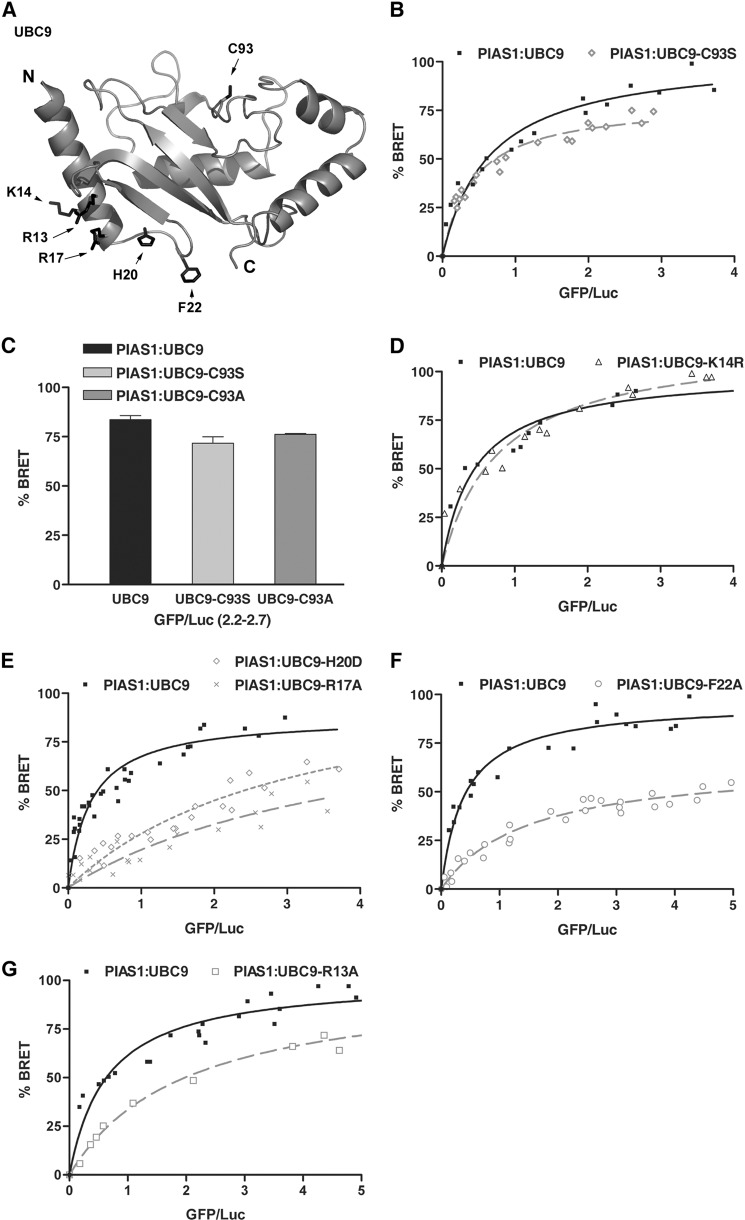FIGURE 2.
The non-covalent interaction between SUMO and UBC9 stabilize the PIAS1·UBC9 complex. A, ribbon representation of human UBC9 (PDB code 1U9A) showing residues Arg-13, Lys-14, Arg-17, His-20, Phe-22, and Cys-93 subjected to mutational analysis. N and C correspond, respectively, to the amino and carboxyl termini of UBC9. B, BRET titration curves obtained with wild-type PIAS1 and either wild-type UBC9 or a catalytically inactive UBC9-C93S mutant. The experiments were performed with a fixed amount of RLuc-PIAS1 and increasing amounts of either UBC9-GFP (■) or UBC9-C93S-GFP (%#x25CA;). For each curve the data from two independent experiments were pooled. 100% BRET corresponds to the maximum BRET signal value of 0.69 measured with the wild-type PIAS1 and UBC9. C, bar graph showing a comparison of the BRET ratios obtained with wild-type PIAS1 and either wild-type UBC9, UBC9-C93S, or the UBC9-C93A mutant at similar GFP acceptor/Luc donor expression ratios. D, BRET titration curves obtained with wild-type PIAS1 and either wild-type UBC9 or the UBC9-K14R mutant. The experiments were performed with a fixed amount of RLuc-PIAS1 and increasing amounts of either UBC9-GFP (■) or UBC9-K14R-GFP (%#x25CA;). 100% BRET corresponds to the maximum BRET signal value of 0.56 measured with wild-type PIAS1 and UBC9. E, BRET titration curves obtained with wild-type PIAS1 and either wild-type UBC9, the UBC9-R17A mutant, or the UBC9-H20D mutant. The experiments were performed with a fixed amount of wild-type RLuc-PIAS1 and increasing amounts of wild-type UBC9-GFP (■), UBC9-R17A-GFP (×), or UBC9-H20D-GFP (%#x25CA;). For each curve the data of at least three independent experiments were pooled, and 100% BRET corresponds to the maximum BRET signal value of 0.50 measured with wild-type PIAS1 and UBC9. F, BRET titration curves obtained with wild-type PIAS1 and either the wild-type UBC9 or the UBC9-F22A mutant. The experiments were performed with a fixed amount of wild-type RLuc-PIAS1 with increasing amounts of wild-type UBC9-GFP (■) or UBC9-F22A-GFP (○). 100% BRET represents the maximum BRET signal value of 0.50 in wild-type curve. G, BRET titration curves obtained with wild-type PIAS1 and either the wild-type UBC9 or the UBC9-R13A mutant. The experiment was performed with a fixed amount of wild-type RLuc-PIAS1 with increasing amounts of wild-type UBC9-GFP (■) or UBC9-R13A-GFP (□). 100% BRET represents a maximum BRET signal value of 0.52 measured with wild-type PIAS1 and UBC9.

